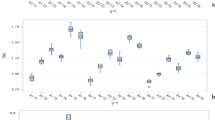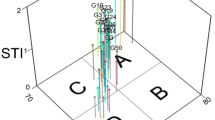Abstract
Wheat production under water-limited conditions is lagging due to our restricted understanding of mechanisms involved in drought tolerance. This study was aimed at the assessment of molecular and physio-biochemical responses of three wheat genotypes including Baran (drought-tolerant), Pishtaz (semi-tolerant) and Zarrin (sensitive). The plants were normally irrigated until the four-leaf stage, and then the irrigation was stopped until the soil moisture reached the desired stress at 100% (normal), 70%, and 40% soil field capacity (FC). The results revealed that leaf total protein content decreased under stress, while proline, catalase (CAT), ascorbate peroxidase (APX), and guaiacol peroxidase (GPX) increased. Drought stress at 40% FC decreased grain yield by 18, 20, and 39% for Barran, Pishtaz, and Zarrin, respectively. The gene expression of CAT, APX, GPX, pyrroline-5-carboxylate synthase (P5CS), and Pyrroline-5-carboxylate reductase (P5CR) significantly increased at drought, and tolerant genotype represented the higher rate of the gene expression compared with other genotypes. The proline level positively and strongly correlated with P5CS and P5CR gene expression. Grain fatty acid profile showed increased polyunsaturated fatty acid and decreased saturated fatty acids in plants experiencing 40% FC over control. Heat map analysis showed that CAT, APX, GPX, and proline with higher variability can be determined as markers to measure drought impacts. Overall, our findings represented the superior genotype for wheat breeding and also showed the physiological and biochemical changes particularly grain fatty acid profile to obtain the better genotype and irrigation regime in terms of human health.







Similar content being viewed by others
References
Aebi H (1984) Catalase in vitro. Methods Enzymol 105:121–126. https://doi.org/10.1016/S0076-6879(84)05016-3
Aslam MN, Nelson MN, Kailis SG, Bayliss KL, Speijers J, Cowling WA (2009) Canola oil increases in polyunsaturated fatty acids and decreases in oleic acid in drought-stressed Mediterranean-type environments. Plant Breed 128(4):348–355. https://doi.org/10.1111/j.1439-0523.2008.01577.x
Ayala-Astorga GI, Alcaraz-Meléndez L (2010) Salinity effects on protein content, lipid peroxidation, pigments, and proline in Paulownia imperialis (Siebold & Zuccarini) and Paulownia fortune (Seemann & Hemsley) grown in vitro. Electron J Biotechnol 13(5):13–14. https://doi.org/10.2225/vol13-issue5-fulltext-13
Bandurska H, Niedziela J, Pietrowska-Borek M, Nu K, Chadzinikolau T, Radzikowska D (2017) Regulation of proline biosynthesis and resistance to drought stress in two barley (Hordeum vulgare L.) genotypes of different origin. Plant Physiol Biochem 118:427–437. https://doi.org/10.21273/JASHS.136.4.247
Bates LS, Waldren RP, Teare LD (1973) Rapid determination of free proline for water stress studies. Plant Soil 39:205–208. https://doi.org/10.1007/BF00018060
Bian S, Jiang Y (2009) Reactive oxygen species, antioxidant enzyme activities and gene expression patterns in leaves and roots of Kentucky bluegrass in response to drought stress and recovery. Sci Hortic 120:264–270. https://doi.org/10.1016/j.scienta.2008.10.014
Blokhina O, Virolainen E, Fagerstedt K (2003) Antioxidants, oxidative damage and oxygen deprivation stress: a review. Ann Bot 91:179–194. https://doi.org/10.1093/aob/mcf118
Borges A, Tsai SM Caldas DGG (2012) Validation of reference genes for RT-qPCR normalization in common bean during biotic and abiotic stresses. Plant Cell Rep 31(5):827–838. https://doi.org/10.1007/s00299-011-1204-x
Bradford MM (1976) A rapid and sensitive method for the quantitation of microgram quantities of protein utilizing the principle of proteinedye binding. Anal Biochem 72:248–254. https://doi.org/10.1006/abio.1976.9999
Castillo FJ, Penel C, Greppin H (1984) Peroxidase release induced by ozone in Sedum album leaves: involvement of Ca2+. Plant Physiol 74(4):846–851. https://doi.org/10.1104/pp.74.4.846
Chakraborty U, Pradhan B (2012) Oxidative stress in five wheat varieties (Triticum aestivum L.) exposed to water stress and study of their antioxidant enzyme defense system, water stress responsive metabolites and H2O2 accumulation. Braz J Plant Physiol 24:2. https://doi.org/10.1590/S1677-04202012000200005
Chaudhari SK, Arshad M, Ilyas N (2017) Physiological and biochemical responses of hexaploid wheat cultivars to drought stress. Pure Appl Biol 6(1):60–71. https://doi.org/10.1046/j.1439-037x.2000.00430.x
Chen F, Wang F, Wu FB, Mao WH, Zhang GP, Zhou MX (2010) Modulation of exogenous glutathione in antioxidant defense system against Cd stress in the two barley genotypes differing in Cd tolerance. Plant Physiol Biochem 48:663–672. https://doi.org/10.1016/j.plaphy.2010.05.001
Djuricic I, Calder PC (2021) Beneficial outcomes of omega-6 and omega-3 polyunsaturated fatty acids on human health: an update for 2021. Nutrients 13(7):2421. https://doi.org/10.3390/nu13072421
Dudziak K, Zapalska M, Börner A, Szczerba H, Kowalczyk K, Nowak M (2019) Analysis of wheat gene expression related to the oxidative stress response and signal transduction under short-term osmotic stress. Sci Rep 9:2743. https://doi.org/10.1038/s41598-019-39154-w
Fard NS, Abad HHS, Rad AS, Heravan EM, Daneshian J (2018) Effect of drought stress on qualitative characteristics of canola cultivars in winter cultivation. Ind Crop Prod 114:87–92
Feizabadi A, Noormohammadi G, Fatehi F (2021) Changes in growth, physiology, and fatty acid profile of rapeseed cultivars treated with vermicompost under drought stress. J Soil Sci Plant Nutr 21(1):200–208
Furlan A, Bianucci E, Tordable M, Castro S, Dietz KJ (2014) Antioxidant enzyme activities and gene expression patterns in peanut nodules during a drought and rehydration cycle. Funct Plant Biol 41:704–713. https://doi.org/10.1071/FP13311
Harb A, Awad D, Samarah N (2015) Gene expression and activity of antioxidant enzymes in barley under controlled severe drought. J Plant Interact 10:109–116. https://doi.org/10.1080/17429145.2015.1033023
He M, Ding NZ (2020) Plant unsaturated fatty acids: multiple roles in stress response. Front Plant Sci 11:562785
Huang CJ, Zhao SY, Wang LC, Shakeel AA, Chen M, Zhou HF (2013) Alteration in chlorophyll fluorescence, lipid peroxidation and antioxidant enzymes activities in hybrid ramie (Boehmeria nivea L.) under drought stress. Aust J Crop Sci 7:594–599
Jamshidi Goharrizi K, Moosavi SS, Amirmahani F (2019) Assessment of changes in growth traits, oxidative stress parameters, and enzymatic and non-enzymatic antioxidant defense mechanisms in Lepidium draba plant under osmotic stress induced by polyethylene glycol. Protoplasma 257(2):459–473. https://doi.org/10.1007/s00709-019-01457-0
Kozłowska M, Gruczyńska E, Ścibisz I, Rudzińska M (2016) Fatty acids and sterols composition, and antioxidant activity of oils extracted from plant seeds. Food Chem 213:450–456. https://doi.org/10.1016/j.foodchem.2016.06.102
Marangoni F, Agostoni C, Borghi C, Catapano AL, Cena H, Ghiselli A, Poli A (2020) Dietary linoleic acid and human health: focus on cardiovascular and cardiometabolic effects. Atherosclerosis 292:90–98. https://doi.org/10.1016/j.atherosclerosis.2019.11.018
Marok M, Tarrago L, Ksas B, Henri P, Abrous-Belbachir O, Havaux M, Rey P (2013) A drought-sensitive barley variety displays oxidative stress and strongly increased contents in low-molecular weight antioxidant compounds during water deficit compared to a tolerant variety. J Plant Physiol 170:633–645. https://doi.org/10.1016/j.jplph.2012.12.008
Mickky B, Aldesuquy H, Elnajar M (2020) Effect of drought on yield of ten wheat cultivars linked with their flag leaf water status, fatty acid profile and shoot vigor at heading. Physiol Mol Biol Plant 26:1111–1117. https://doi.org/10.1007/s10681-020-02672-0
Nakano Y, Asada K (1981) Spinach chloroplasts scavenge hydrogen peroxide on illumination. Plant Cell Physiol 21:1295–1307. https://doi.org/10.1093/oxfordjournals.pcp.a076128
Nasirzadeh L, Sorkhilaleloo B, Hervan EM, Fatehi F (2021) Changes in antioxidant enzyme activities and gene expression profiles under drought stress in tolerant, intermediate, and susceptible wheat genotypes. Cereal Res Commun 49(1):83–89
Norouzi P, Sabzehzari M, Zeinali H (2015) Efficiency of some molecular markers linked to rhizomania resistance gene (Rz1) for marker assisted selection in sugar beet. J Crop Sci Biotechnol 18:319–323. https://doi.org/10.1007/s12892-015-0033-9
Pfaffl MW (2001) A new mathematical model for relative quantification in real-time RT-PCR. Nucleic Acids Res 29:2002–2007. https://doi.org/10.1093/nar/29.9.e45
Qasim M, Ashraf M, Ashraf M, Rehman S-U, Rha E (2003) Salt-induced changes in two canola cultivars differing in salt tolerance. Biol Plant 46(4):629–632. https://doi.org/10.1023/A:1024844402000
Rozen S, Skaletsky HJ (2000) Primer3 on the WWW for general users and for biologist programmers. Methods Mol Biol 132:365–386. https://doi.org/10.1385/1-59259-192-2:365
Sabagh AE, Hossain A, Barutçular C, Islam MS, Ratnasekera D, Kumar N, da Silva JAT (2019) Drought and salinity stress management for higher and sustainable canola (Brassica napus L) production: a critical review. Austr J Crop Sci 13(1):88–96
Sairam RK, Tyagi A (2004) Physiology and molecular biology of salinity stress tolerance in plants. Curr Sci 86:407–421. https://doi.org/10.1007/1-4020-4225-6
Sánchez-Martín J, Canales FJ, Tweed JK, Lee MR, Rubiales D, Gómez-Cadenas A, Prats E (2018) Fatty acid profile changes during gradual soil water depletion in oats suggests a role for jasmonates in coping with drought. Front Plant Sci 9:1077
Sedri MH, Amini A, Golchin A (2019) Evaluation of nitrogen effects on yield and drought tolerance of rainfed wheat using drought stress indices. J Crop Sci Biotechnol 22(3):235–242. https://doi.org/10.1007/s12892-018-0037-0
Sofo A, Scopa A, Nuzzaci M, Vitti A (2015) Ascorbate peroxidase and catalase activities and their genetic regulation in plants subjected to drought and salinity stresses. Int J Mol Sci 16:13561–13578. https://doi.org/10.3390/ijms160613561
Ueda A, Yamamoto-Yamane Y, Takabe T (2007) Salt stress enhances proline utilization in the apical region of barley roots. Biochem Biophys Res Commun 355:61–66. https://doi.org/10.1016/j.bbrc.2007.01.098
Valifard M, Moradshahi A, Kholdebarin B (2012) Biochemical and physiological responses of two wheat (Triticum aestivum L.) cultivars to drought stress applied at seedling stage. J Agric Sci Technol 14:1567–1578
Wang X, Xiao H, Chen G, Zhao X, Huang C, Chen C, Wang F (2011) Isolation of high-quality RNA from Reaumuria soongorica, a desert plant rich in secondary metabolites. Mol Biotechnol 48(2):165–172. https://doi.org/10.1007/s12033-010-9357-3
Wang JY, Turner NC, Liu YX, Siddique KHM, Xiong YC (2017) Effects of drought stress on morphological, physiological and biochemical characteristics of wheat species differing in ploidy level. Funct Plant Biol 44(2):219–234. https://doi.org/10.1071/FP16082
Wang X, Yanhua X, Jingjing L, Ren Y, Wang Z, Xin Z, Lin T (2018) Identification of two novel wheat drought tolerance-related proteins by comparative proteomic analysis combined with virus-induced gene silencing. Int J Mol Sci 19:4020. https://doi.org/10.1038/s41598-019-44958-x
Wang XP, Liu HL, Yu FL, Hu BW, Jia Y, Sha HJ (2019) Differential activity of the antioxidant defense system and alterations in the accumulation of osmolyte and reactive oxygen species under drought stress and recovery in rice (Oryza sativa L.). Tiller Sci Rep 9:8543. https://doi.org/10.1038/s41598-019-44958-x
Warleta F, Campos M, Allouche Y, Sánchez-Quesada C, Ruiz-Mora J, Beltrán G, Gaforio JJ (2010) Squalene protects against oxidative DNA damage in MCF10A human mammary epithelial cells but not in MCF7 and MDA-MB-231 human breast cancer cells. Food Chem Toxicol 48(4):1092–1100. https://doi.org/10.1016/j.fct.2010.01.031
Yan M, Xue C, Xiong Y, Meng X, Li B, Shen R, Lan P (2020) Proteomic dissection of the similar and different responses of wheat to drought, salinity and submergence during seed germination. J Proteomics 220:103756. https://doi.org/10.1016/j.jprot.2020.103756
Yanlei F, Hailing M, Siying C, Tianyu G, Jiming G (2017) Control of proline accumulation under drought via a novel pathway comprising the histone methylase CAU1 and the transcription factor ANAC055. J Exp Bot 69:579–588. https://doi.org/10.1093/jxb/erx419
Zhang X, Yang Z, Li Z (2020) Effects of drought stress on physiology and antioxidative activity in two varieties of Cynanchum thesioides. Braz J Bot 43:1–10. https://doi.org/10.1007/s40415-019-00573-8
Acknowledgements
Not applicable.
Funding
Not applicable.
Author information
Authors and Affiliations
Contributions
The data were prepared by MD, MRB, EM, and RA; The initial draft was prepared by MD and revised by all co-authors.
Corresponding author
Ethics declarations
Conflict of interest
The authors declare that they have no conflict of interest.
Additional information
Communicated by Hakan Özkan.
Rights and permissions
Springer Nature or its licensor (e.g. a society or other partner) holds exclusive rights to this article under a publishing agreement with the author(s) or other rightsholder(s); author self-archiving of the accepted manuscript version of this article is solely governed by the terms of such publishing agreement and applicable law.
About this article
Cite this article
Dashtaki, M., Bihamta, M.R., Majidi, E. et al. Differential responses of wheat genotypes to irrigation regimes through antioxidant defense system, grain yield, gene expression, and grain fatty acid profile. CEREAL RESEARCH COMMUNICATIONS 51, 879–890 (2023). https://doi.org/10.1007/s42976-022-00336-4
Received:
Accepted:
Published:
Issue Date:
DOI: https://doi.org/10.1007/s42976-022-00336-4




